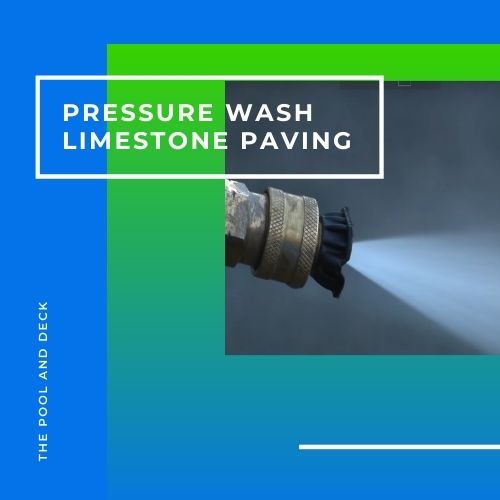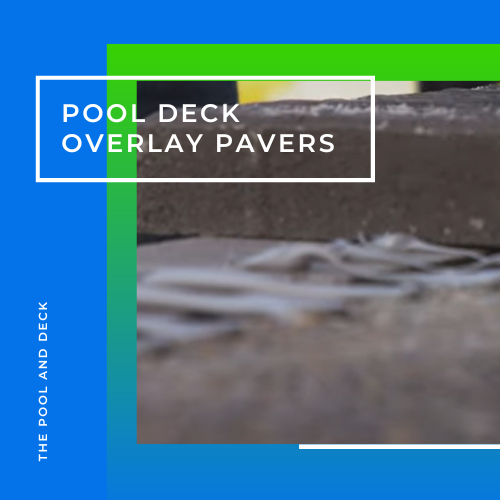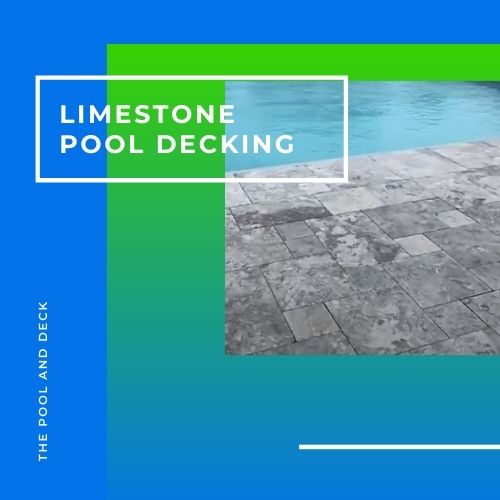How To Pressure Wash Limestone Paving? (The Right Way Explained!)
As an Amazon Associate, I earn from qualifying purchases.
Table of Contents
Can You Pressure Wash a Limestone Patio?
You probably spend a lot of time on your limestone patio, enjoying the outdoors. It’s your favorite place for a cup of morning coffee or a pre-dinner glass of wine. Limestone paving on a patio looks so pristine when it is new. But how do you keep it clean all the time? Can you pressure wash the limestone paving on the patio?
Always pressure wash limestone paving on your patio at the lowest pressure setting. Use a rotary surface cleaner attachment for better control. If spraying directly from the wand use the fan nozzle and keep the tip 2’ above the patio floor.

Limestone pavers have to be sealed as limestone is a very porous stone. Without the protection of a sealer, water will penetrate into the pores and corrode limestone from inside.
Wet or moist limestone pavers encourage growth of microbes such as mold, mildew, fungus and algae.
Porous limestone pavers with little or no protection from a sealer will stain more easily. The stains will not just stay on the patio surface. They will penetrate. Stains that get embedded are extremely difficult to get rid of.
A sealer gets depleted due to weathering and normal wear & tear. Pressure wash of limestone pavers further depletes the sealer. You will therefore need to reseal the limestone patio after you power wash it.
Limestone Hardness
Limestone is quite durable but it is not particularly hard. Hardness is a measure of a stone’s ability to resist abrasion, marring and scratches. Hardness is measured on the Mohs scale. Mohs scale is a relative scale with diamond at 10 and talc at 1.
Limestone scores 3 on Mohs scale. It is soft enough to get damaged by a strong pressure wash. The reason to pressure wash a limestone patio softly is to prevent it from abrasion and loss of the sealer.
Do You Need a Special Cleaner for Pressure Washer?
Just spraying water at high pressure from the pressure washer will not get your patio clean. It may actually make it pretty messy. You must adopt a step by step process of cleaning your patio. Follow these 5 steps and you will have a clean sparkling patio.
STEP 1:
Sweep the patio when it is dry with a soft broom or a soft bristled synthetic brush. You will be able to get rid of the dust & debris before it gets wet and embedded in the porous limestone patio paving.
STEP 2:
Rinse the patio with a garden hose. Pour a pH neutral soap solution, such as Dawn, on the patio. Scrub the patio with a soft bristled brush. Rinse off with clean water using a garden hose.
STEP 3:
Identify the stains that may be there on the patio. Not all stains are the same. Often a specific stain will require a specific stain remover. Do not use highly acidic stain removers such as bleach, vinegar etc. on limestone paving. They will corrode and discolor your patio.
To get rid of stubborn stains use Miracle Sealants Poultice Plus. It is an easy to use, fine, non-acidic absorbent powder. The bleach free formula works, when mixed with distilled water, to draw stains out from limestone pavers & tiles.
For more information on cleaning limestone pavers, check out my article, You Need To Clean A Limestone Pool Deck This Way!
If the patio looks clean & presentable, you may even skip the next two steps. You want to pressure wash limestone paving as less as possible.
STEP 4:
Pressure wash the patio using a good quality, pH neutral cleaner. The process to follow is:
- Wet the patio with clean water using a garden hose
- Prepare a solution of the deck cleaner in a bucket of water (or as per directions on the packaging). Broadcast the cleaner on the patio floor
- Leave the cleaner on the patio for some time but make sure it does not dry up. The cleaner will lift off the grime
- Pressure wash at low pressure and at an angle. A rotary surface cleaner attachment is very helpful
- Pressure wash the patio once again to rinse off the cleaner & grime residue
STEP 5:
Check the condition of the sealer, after the pressure wash of the limestone patio paving. If it is no longer stopping water from permeating into the porous limestone paver, then you will need to reseal. The process is explained later in the post.
What Is the Best Cleaner to Use in a Pressure Washer?
It is common to use household products like chlorine, bleach, vinegar, baking soda or ammonia to clean decks. However, none of these are good for limestone paving. Why? Because they are either acidic or alkaline.
Limestone is a sedimentary rock characterized by high porosity and high calcite content. Both, acids & alkalis, will penetrate deep into limestone, react with the calcite and corrode it.
You must always use pH neutral cleaners on Limestone Paving.
Black Diamond’s Stone Wash is formulated specifically to clean porous natural stone surfaces such as limestone. Stone Wash is pH neutral and biodegradable. Stone Wash lifts dirt effortlessly from natural stone without damaging the surface or diminishing natural stone color.
Alternatively you can use cleaning products that are formulated using hydrogen peroxide.
Simple Green Oxy Solve Total Outdoor Pressure Washer Cleaner lifts away tough grime, oil & grease stains and stains from mold, mildew, algae, etc. using the power of hydrogen peroxide. No harsh chemicals are included in the formulation.
How Do You Pressure Wash Without Leaving Lines?
All pressure washers come with a psi rating. This is the maximum water pressure that the pressure washer will deliver. This is the pressure at the wand nozzle tip.
The water pressure that is created on the deck surface drops & depends on the spray :
- Distance
- Spread
- Angle
If you do not want the water pressure to make lines on your limestone patio then you need to control the spray distance, spread & angle.
Moreover, you have to keep the spray moving across the deck in slow, but uniform, overlapping, circular motion. Avoid spraying the same area continuously for too long.
I must admit that this is easier said than done. The spray gun is well, ultimately a kind of a gun. And don’t we love playing with guns? Not surprisingly, we get trigger happy and go full blast!
Use a rotary surface cleaner attachment at the end of the wand. This will automatically control the distance, spread and angle of the water spray.The attachment has:
- Two rotating flat jet nozzles
- Splash guard
- Adjustable height
You might want to check out Karcher Universal 11″ Pressure Washer Surface Cleaner Attachment for Electric Power Pressure Washers.

Its key features are:
- Universal Compatibility: Compatible with Karcher & most non-Karcher pressure washers
- Efficient Cleaning: Two high RPM spinning nozzles instead of one
- Multi-Surface Cleaner: Works on concrete, driveways, patios, decks, sidewalks and more
- Splash-Free Skirt: A shroud and splash-free skirt minimize overspray
- Superior Clean: Eliminates streaks as nozzles at a fixed height from the deck
Do You Need to Reseal Limestone?
Re-Sand
Before you start on the resealing process you must check the status of sand between the limestone patio paving. Rain, wind and snow melt, along with normal wear & tear might have depleted or loosened the sand between paver joints.
Check out my article Why Re-Sand Pavers; How To Do It & What Is The Best Sand?
The best sand for paver joints is polymeric sand. Polymeric sand is a fine sand that is combined with additives that form a binding agent when exposed to water. Water activates the setting of the polymeric sand
Polymeric sand is great for pavers in 4 ways:
- Prevents weed growth from bottom
- Stops insects from burrowing from the top
- Keeps pavers together & prevents shifting
- Blocks water penetration
Check out Polymeric Sand for Paver Joints
Re-Seal
Limestone is a soft & porous stone. It must be kept well sealed at all times. Even the best sealers have a service life. Pressure washing pavers only shortens the life. Chances are once you are done pressure washing your limestone patio, you will you will need to reseal it.
Conduct a simple test to find out if your patio needs to be resealed.
Sprinkle a few drops of water on the dry limestone patio. If the water beads up, then the sealer is still effective. No need to reseal. But if the water gets absorbed then you certainly need to reseal.
Impregnating Stone Sealers penetrate into the pores of limestone, solidify and block them. Water, stains or harmful chemicals can not enter the pores after the limestone has been sealed.
Recommended Product: Miracle Sealants 511QT6 511 Impregnator Sealer.
To conclude you can pressure wash your limestone patio paving but do it gently and only occasionally. Do not forget to check the sealer effectiveness after the pressure wash and reseal, if required.
For all your Tile & Paver needs, click on the link below:
StoneTileDepotThank you very much for reading the post. I do hope you found it informative and helpful.







